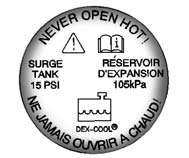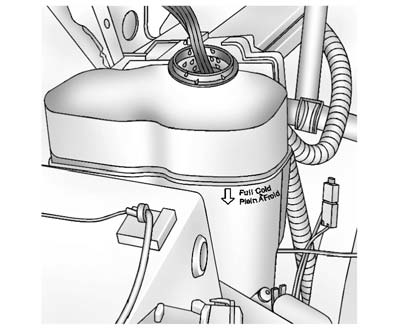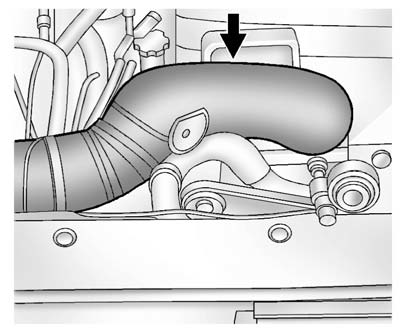 Cadillac Escalade: How to Add Coolant to the Surge Tank
Cadillac Escalade: How to Add Coolant to the Surge Tank
![]() WARNING
WARNING
You can be burned if you spill coolant on hot engine parts. Coolant contains ethylene glycol and it will burn if the engine parts are hot enough. Do not spill coolant on a hot engine.
Notice: This vehicle has a specific coolant fill procedure. Failure to follow this procedure could cause the engine to overheat and be severely damaged.
![]() WARNING
WARNING
An electric engine cooling fan under the hood can start up even when the engine is not running and can cause injury. Keep hands, clothing, and tools away from any underhood electric fan.
![]() WARNING
WARNING
Steam and scalding liquids from a hot cooling system can blow out and burn you badly. They are under pressure, and if you turn the surge tank pressure cap—even a little—they can come out at high speed. Never turn the cap when the cooling system, including the surge tank pressure cap, is hot. Wait for the cooling system and surge tank pressure cap to cool if you ever have to turn the pressure cap.
If no coolant is visible in the surge tank, add coolant as follows:

1. Remove the coolant surge tank pressure cap when the cooling system, including the coolant surge tank pressure cap and upper radiator hose, is no longer hot.
Turn the pressure cap slowly counterclockwise about one full turn. If a hiss is heard, wait for that to stop. A hiss means there is still some pressure left.
2. Keep turning the pressure cap slowly and remove it.

3. Fill the coolant surge tank with the proper mixture to the FULL COLD mark.

4. With the coolant surge tank pressure cap off, start the engine and let it run until the upper radiator hose can be felt getting hot. Watch out for the engine cooling fan.
By this time, the coolant level inside the coolant surge tank may be lower. If the level is lower, add more of the proper mixture to the coolant surge tank until the level reaches the FULL COLD mark.
5. Replace the pressure cap. Be sure the pressure cap is hand-tight and fully seated.
6. Verify coolant level after engine is shut off and the coolant is cold. If necessary, repeat coolant fill procedure Steps 1 through 6.
Notice: If the pressure cap is not tightly installed, coolant loss and possible engine damage may occur. Be sure the cap is properly and tightly secured.
 Checking Coolant
Checking Coolant
The vehicle must be on a level surface when checking the coolant level.
Check to see if coolant is visible in the coolant surge tank. If the coolant
inside the coolant surge tank is boiling, do not ...
 Engine Overheating
Engine Overheating
The vehicle has several indicators to warn of engine overheating.
There is a coolant temperature gauge on your vehicle's instrument panel. See
Engine Coolant Temperature Gauge .
In additi ...
See also:
Removing a wheel
► Unscrew the uppermost wheel bolt
completely.
► Screw alignment bolt 1 into the thread
instead of the wheel bolt.
► Unscrew the remaining wheel bolts fully.
Do not place wh ...
Recalling a previous destination
After selecting Previous destinations from the menu, the screen shows a list
of stored previous destinations. Select your destination by touching the bar. The
details will be displayed for confirm ...
Air Vents
Use the slider switch in the center of the outlet, to change the direction of
the airflow. Use the thumbwheel near the outlet to control the amount of airflow
or to shut off the airflow.
Keep all ...






